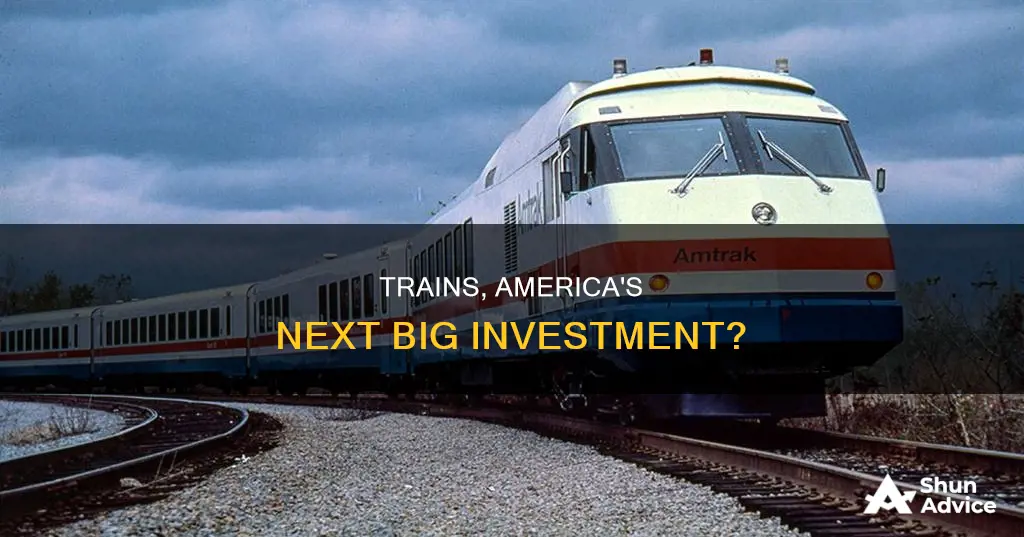
America has a car culture. In the late 1950s, the US government spent billions of dollars on a national highway programme, aviation industry subsidies, and canal projects. In contrast, the passenger rail industry received no taxpayer support.
However, there are signs that this could be changing. The US has the most railroad tracks in the world, and there are numerous projects aiming to add high-speed rail networks to the country. For example, the Infrastructure Investment and Jobs Act included $66 billion for passenger and freight rail improvements.
| Characteristics | Values |
|---|---|
| Current investment in trains | $36 billion in funding for rail projects from the Senate's infrastructure bill |
| $66 billion for passenger and freight rail improvement from the Infrastructure Investment and Jobs Act | |
| $22 billion dedicated for Amtrak's fleet, stations, accessibility, and infrastructure projects | |
| Benefits of investing in trains | Economic growth |
| Environmental benefits | |
| More travel options | |
| Cheaper transportation | |
| Drawbacks of investing in trains | High cost |
| Long construction times | |
| Few passengers | |
| No improvements to freight service |
What You'll Learn
- The US has the most railroad tracks in the world, but most are used for freight
- The US has a car culture and decades of subsidising other transport methods over rail
- The benefits of high-speed rail include reduced carbon footprint, improved air quality, and less congestion
- High-speed rail is safer and more energy-efficient than flying or driving
- High-speed rail can revitalise left-behind cities and suburbs, connecting them to urban centres

The US has the most railroad tracks in the world, but most are used for freight
The United States has the largest rail transport network in the world, with approximately 160,000 miles of railroad tracks. However, the majority of these tracks are used for freight shipments rather than passenger service. This is due in part to the country's “car culture" and the historical lack of investment in passenger rail infrastructure. Private rail companies have had to foot the bill for maintenance and new construction projects, while other modes of transportation, such as highways and aviation, have received significant government subsidies.
The US freight rail network is widely considered the largest, safest, and most cost-efficient in the world. It is operated by seven Class I railroads and numerous regional and local railroads, providing over 167,000 jobs across the country. The network spans across 140,000 miles, connecting communities and supporting economic growth. Unlike passenger rail services, freight railroads are privately owned, allowing them to raise billions in private capital for maintenance and expansion.
The efficiency and cost-effectiveness of freight railroads in the US are notable. Trains are three to four times more fuel-efficient than trucks, reducing greenhouse gas emissions by up to 75%. Additionally, railroads can move more freight at once, with American railroads moving more than 5,000 ton-miles of freight per person per year, compared to 500 ton-miles in Europe and less than 170 ton-miles in Japan. This efficiency benefits both producers and consumers, as goods can be shipped more cheaply and efficiently by rail.
While passenger rail service is available in the US, it is not as extensive or high-speed as in some other countries. However, there are efforts to improve and expand passenger rail services. For the first time, there is transformative funding for passenger rail, with Congress passing the Infrastructure Investment and Jobs Act, which includes $66 billion for passenger and freight rail improvement. This includes funding for new and enhanced passenger rail corridors and projects to enhance mobility, drive economic growth, and reduce emissions.
Coinbase: Where to Invest Today
You may want to see also

The US has a car culture and decades of subsidising other transport methods over rail
The United States has a long history of car culture, which has had a significant influence on the country's culture and development. After World War II, the American manufacturing economy shifted from producing war-related items to consumer goods, particularly automobiles. By the end of the 1950s, one in six working Americans was employed directly or indirectly in the automotive industry, and the country had become the world's largest manufacturer of automobiles. This shift was driven by Henry Ford's goal of making car ownership accessible to anyone with a good job.
The growth of car culture was also facilitated by the expansion of the National Highway System with Interstate highways. These wider, multi-lane highways allowed faster travel with fewer interruptions, and the open spaces along the highways became prime locations for billboards and advertisements. The construction of highways and bridges, along with the increasing availability of cars, allowed people to live beyond major cities and commute to work. This led to the development of suburbs, with land developers buying land just outside city limits to build mass quantities of inexpensive tract housing. By the end of the 1950s, one-third of Americans lived in the suburbs, and car ownership became essential for those living outside of big cities.
The automobile and the interstate highway system became symbols of individuality and freedom. Car buyers also began to associate their vehicle with their social standing and level of affluence, and it became an extension of their personality and self-concept. The 1950s saw the emergence of a new generation of service businesses catering specifically to customers with automobiles, including drive-through restaurants, drive-in theaters, and shopping malls located in the suburbs.
However, this car culture has had detrimental effects on the environment, culture, and economics. The production, use, and infrastructure required to support cars have significant environmental impacts, contributing to climate change. Additionally, car culture has resulted in unwalkable suburbs, which can contribute to poor health and discourage active modes of transportation like walking and biking. The high cost of car ownership can also be a financial burden, with the average price of a new car being steep compared to the yearly salary of many Americans.
Despite these negative consequences, the US has historically subsidised other modes of transportation over rail. According to Jim Mathews, president and CEO of the Rail Passengers Association, the US government spent billions of dollars in the late 1950s on a national highway program, aviation industry subsidies, and canal projects, while the passenger rail industry received no taxpayer support. Private rail companies were left to fund maintenance and construction projects on their own, and they ended up paying millions in taxes instead of receiving taxpayer funding.
This disparity in funding has contributed to the US lagging behind other parts of the world in terms of train travel infrastructure. However, there is a growing recognition of the benefits of investing in passenger rail. Train travel offers cultural, economic, and environmental advantages, including more travel options, cheaper transportation, and a reduced carbon footprint.
Investing in Startups: Where to Begin?
You may want to see also

The benefits of high-speed rail include reduced carbon footprint, improved air quality, and less congestion
The United States has a "car culture" and has lagged behind other parts of the world in terms of train travel. However, there are several benefits to investing in high-speed rail, including reduced carbon footprint, improved air quality, and less congestion.
High-speed rail is much more fuel-efficient than other modes of transport. For example, Amtrak claims that travelling by Amtrak NEC train produces 83% less carbon emission than driving alone and up to 73% less than flying. According to Project Drawdown, high-speed rail reduces carbon emissions by up to 90% compared to driving, flying, or riding conventional rail. With more routes, there would be more passengers, and the carbon footprint reduction would be substantial.
High-speed trains could also help reduce smog and air pollution in cities. The number of cars required to transport the same number of people as a high-speed train would release much more pollution into the city. With fewer cars in city centres, there would be more space for people, and cities would be more walkable.
High-speed rail can also help reduce congestion. A single train track can carry the same number of people as a ten-lane highway, and it is much faster for trips of less than 400 miles. This would help reduce the time and money lost due to traffic jams, which cost the US $87.2 billion a year.
In conclusion, investing in high-speed rail in the US would bring about a range of benefits, including a reduced carbon footprint, improved air quality, and less congestion. These improvements would have long-lasting benefits for communities and the environment.
Nokia's Resurgence: Why Investors are Buying
You may want to see also

High-speed rail is safer and more energy-efficient than flying or driving
America has the largest rail network in the world, with more than twice as much track as China. However, it lags behind other countries in ridership. Transportation is a major contributor to US emissions, accounting for about 29% of the total, and rail proponents argue that investing in trains is key to reducing this figure.
High-speed rail is significantly more energy-efficient than flying or driving. According to the International Association of Railways, it is eight times more efficient than flying and four times more efficient than driving. This means that high-speed rail can play a crucial role in reducing greenhouse gas emissions and improving air quality.
In addition to its environmental benefits, high-speed rail can also improve safety. Rail transport has lower resistance to motion than road transportation, thanks to its hard steel wheels on steel rails. This reduces the risk of accidents and makes it a safer option for travellers.
Furthermore, high-speed rail can provide a much-needed boost to the economy. Every $1 invested creates $4 in economic benefits, and it is estimated that Amtrak's long-distance network contributes around $5 billion to the US economy each year. High-speed rail can also reduce congestion, which currently costs the nation $140 billion in lost time and productivity.
The US government has begun to recognise the potential of high-speed rail, with Congress introducing a bipartisan infrastructure bill that includes $36 billion in funding for rail projects. These investments will improve accessibility, boost economic growth, and contribute to a greener future for the nation.
Advertising's Impact: Exploring the Demand-Side Dynamics
You may want to see also

High-speed rail can revitalise left-behind cities and suburbs, connecting them to urban centres
High-speed rail has the potential to revitalise left-behind cities and suburbs, connecting them to urban centres and offering a range of benefits.
Firstly, high-speed rail can drive economic revitalisation in areas outside urban centres. By reducing travel time between cities, high-speed rail makes it easier for businesses and commuters to access opportunities in nearby urban areas, promoting economic growth and revitalising left-behind areas. This can also help address issues of housing affordability and population density in congested urban centres by providing attractive alternative locations for people to live and work.
Secondly, high-speed rail can contribute to innovation and knowledge dissemination. Research has shown that high-speed rail significantly increases urban innovation by improving the agglomeration of innovation factors such as population and investment. It facilitates face-to-face communication and knowledge exchange between entrepreneurs, scientists, and technologists, leading to increased collaboration and innovation.
Thirdly, high-speed rail offers environmental benefits by providing a more energy-efficient mode of transportation than cars or planes. With growing concerns about climate change, high-speed rail presents a promising way to reduce carbon emissions and improve air quality.
Finally, high-speed rail can enhance social connectivity and accessibility. It provides a convenient and comfortable way for people to travel and connect with family and friends, improving social well-being and reducing social isolation, especially in regional areas.
In conclusion, high-speed rail has the potential to revitalise left-behind cities and suburbs by improving economic opportunities, driving innovation, benefiting the environment, and enhancing social connectivity. However, realising these benefits requires careful planning, overcoming logistical challenges, and securing sufficient investment, as highlighted by the challenges faced by some US high-speed rail projects.
Dollar General: A Smart Investment Move?
You may want to see also
Frequently asked questions
The US has a car culture and lags behind other countries in terms of train travel. Investing in trains would bring economic growth to communities, provide more travel options, and help reduce carbon emissions.
High-speed rail enables passengers to travel long distances more quickly and efficiently than by plane or car. It also has a smaller carbon footprint than driving or flying, and can help reduce congestion.
Implementing high-speed rail in the US faces logistical and political challenges, including the high cost of building infrastructure and maintaining it to precise standards. There is also the challenge of redirecting funding from road and bridge projects, as well as the impact on existing freight rail services.
The California High-Speed Rail Authority is currently constructing a high-speed rail line between Los Angeles and San Francisco. However, the project has faced numerous challenges, including increasing costs and waning public and political support. There are also proposed routes linking Boston and New York, Dallas and Houston, Portland, Seattle, and Vancouver, and LA and San Francisco.







